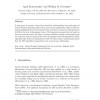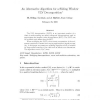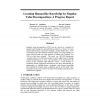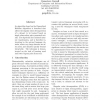IPM
2006
14 years 7 months ago
2006
In this paper we present a theoretical model for understanding the performance of Latent Semantic Indexing (LSI) search and retrieval applications. Many models for understanding L...
IJCV
2006
14 years 7 months ago
2006
: Linear subspace analysis (LSA) has become rather ubiquitous in a wide range of problems arising in pattern recognition and computer vision. The essence of these approaches is tha...
IJCSA
2006
14 years 7 months ago
2006
In this paper we examine the use of a matrix factorization technique called Singular Value Decomposition (SVD) along with demographic information
COMPUTING
2006
14 years 7 months ago
2006
The ULV decomposition (ULVD) is an important member of a class of rank-revealing two-sided orthogonal decompositions used to approximate the singular value decomposition (SVD). Th...
BMCBI
2010
14 years 7 months ago
2010
Background: Protein-protein interaction (PPI) plays essential roles in cellular functions. The cost, time and other limitations associated with the current experimental methods ha...
ICA
2010
Springer
14 years 8 months ago
2010
Springer
In this work we present a method for the estimation of a rank-one pattern living in two heterogeneous spaces, when observed through a mixture in multiple observation sets. Using a ...
NIPS
1997
14 years 8 months ago
1997
Singular value decomposition (SVD) can be viewed as a method for unsupervised training of a network that associates two classes of events reciprocally by linear connections throug...
CAINE
2001
14 years 9 months ago
2001
In this paper, a new method for the approximation of discrete time state-affine systems is proposed. The method is based on the diagonalization of proposed generalized controllabi...
EACL
2006
ACL Anthology
14 years 9 months ago
2006
ACL Anthology
An algorithm based on the Generalized Hebbian Algorithm is described that allows the singular value decomposition of a dataset to be learned based on single observation pairs pres...
CLA
2004
14 years 9 months ago
2004
Abstract. Latent semantic indexing (LSI) is an application of numerical method called singular value decomposition (SVD), which discovers latent semantic in documents by creating c...




